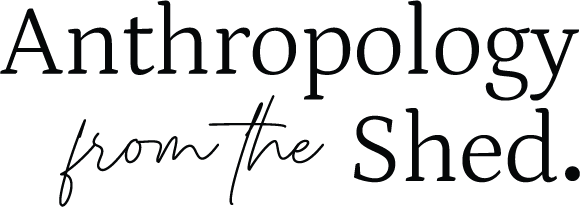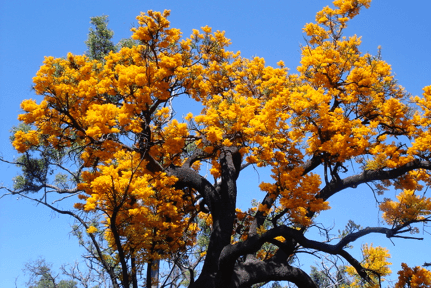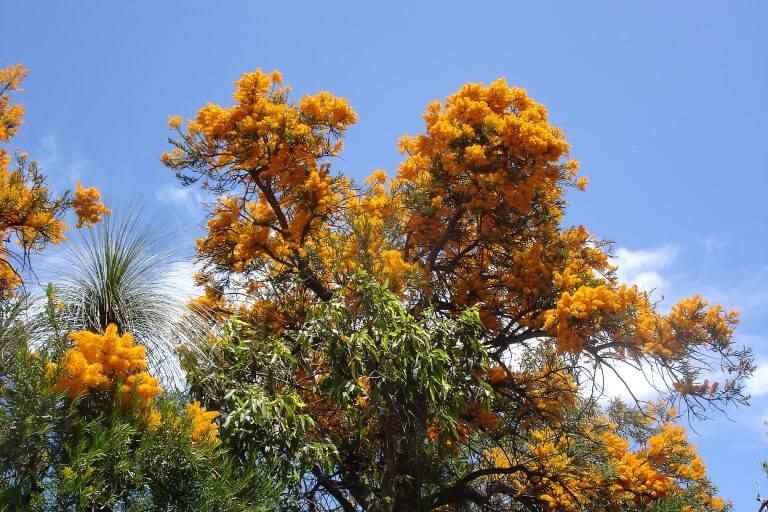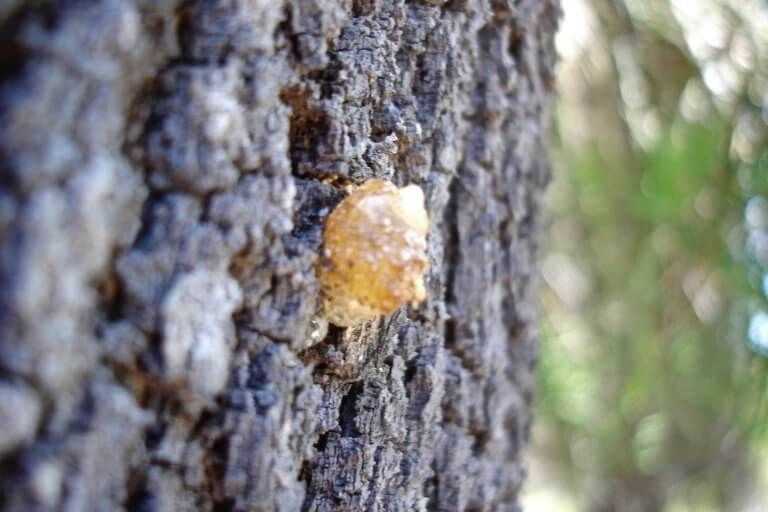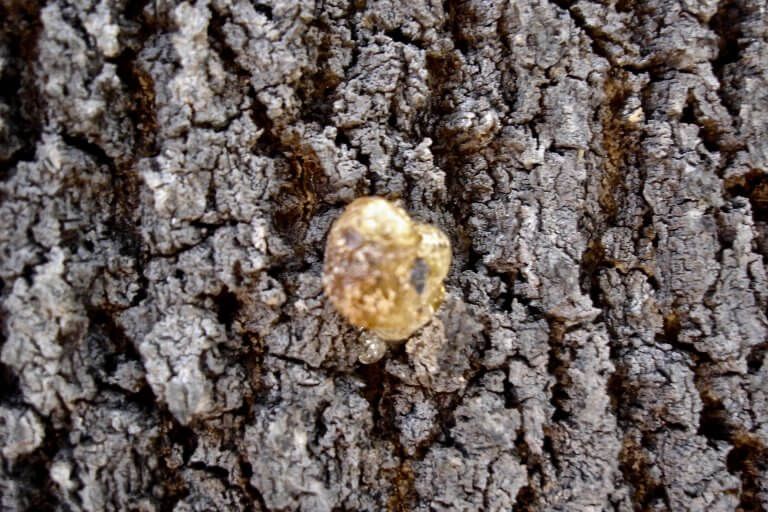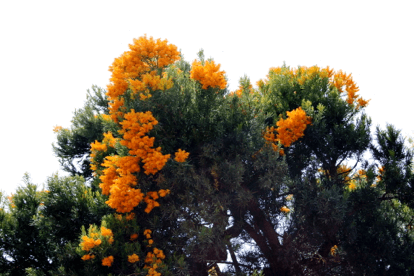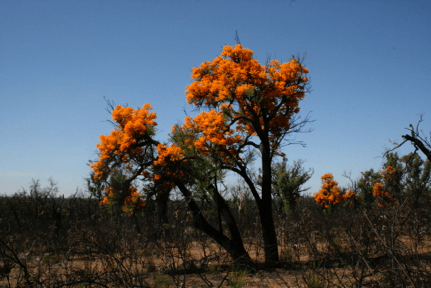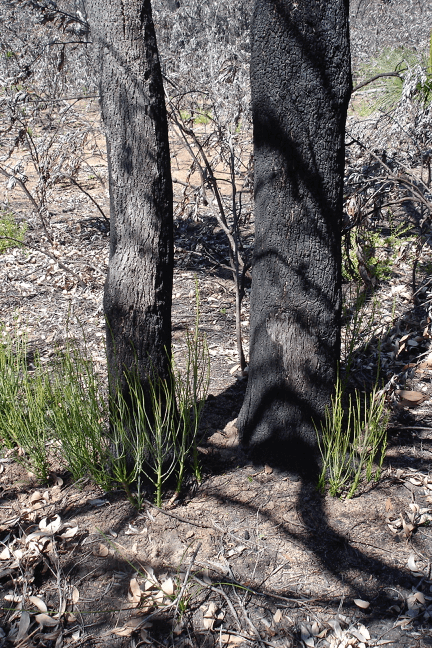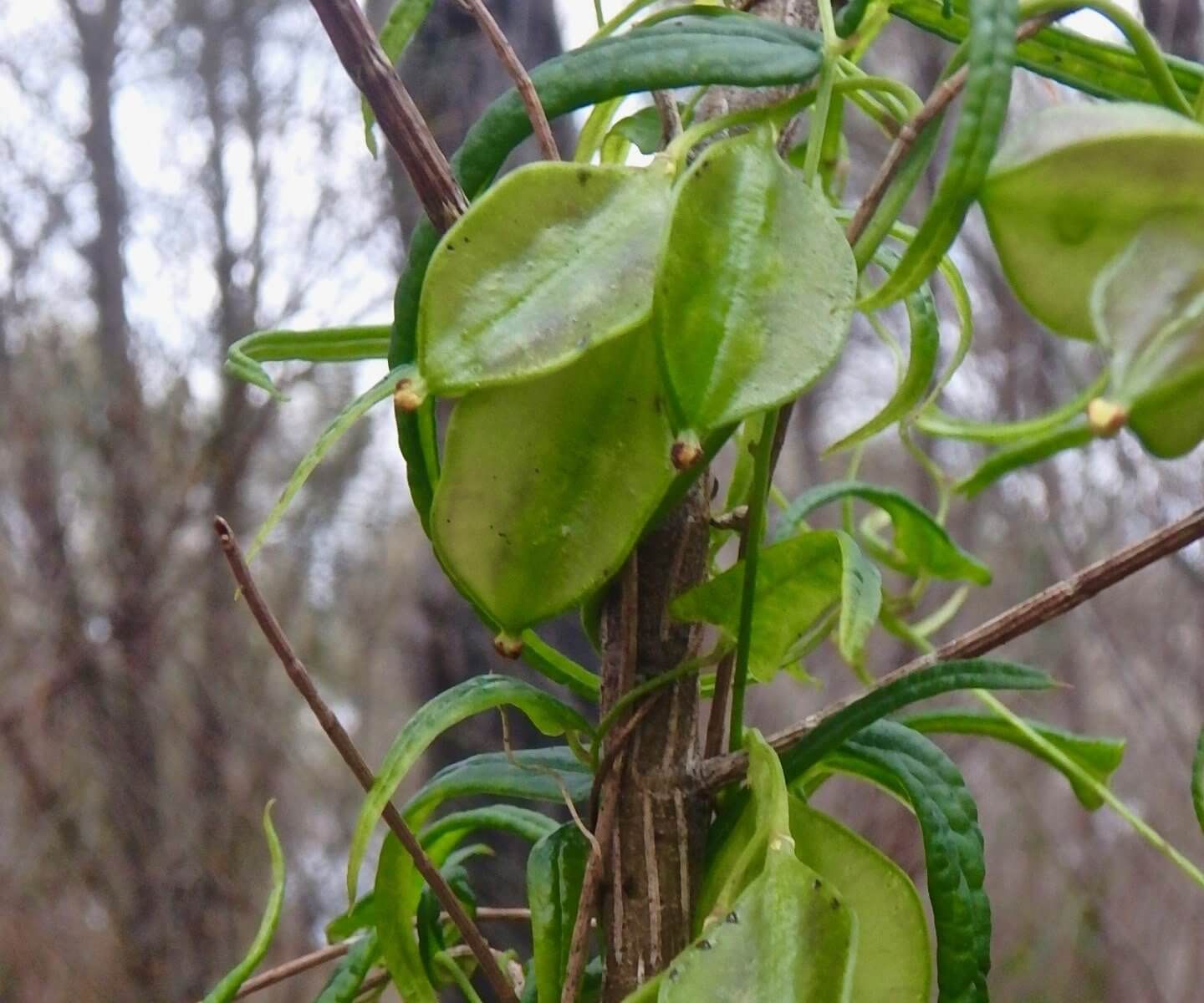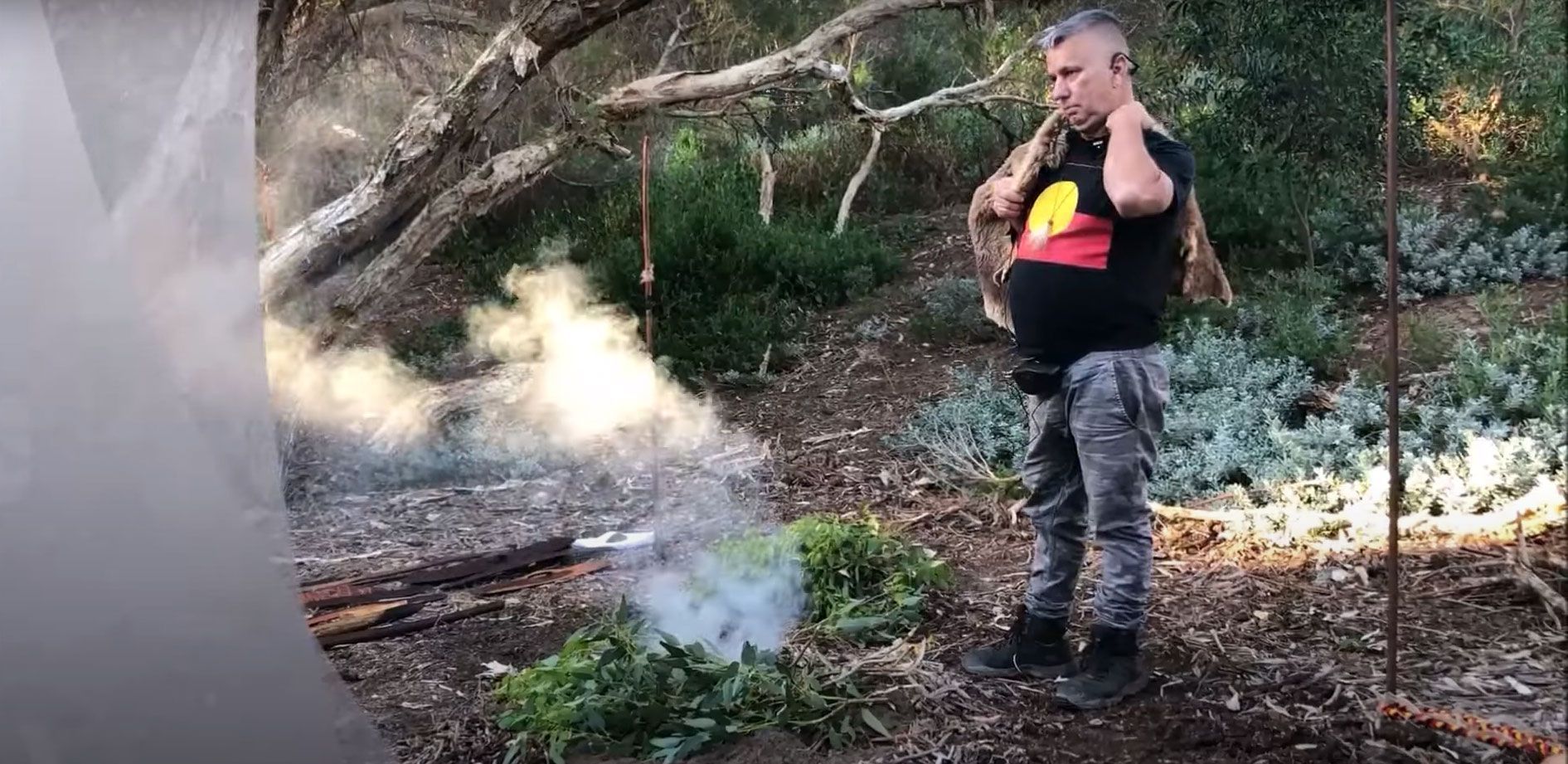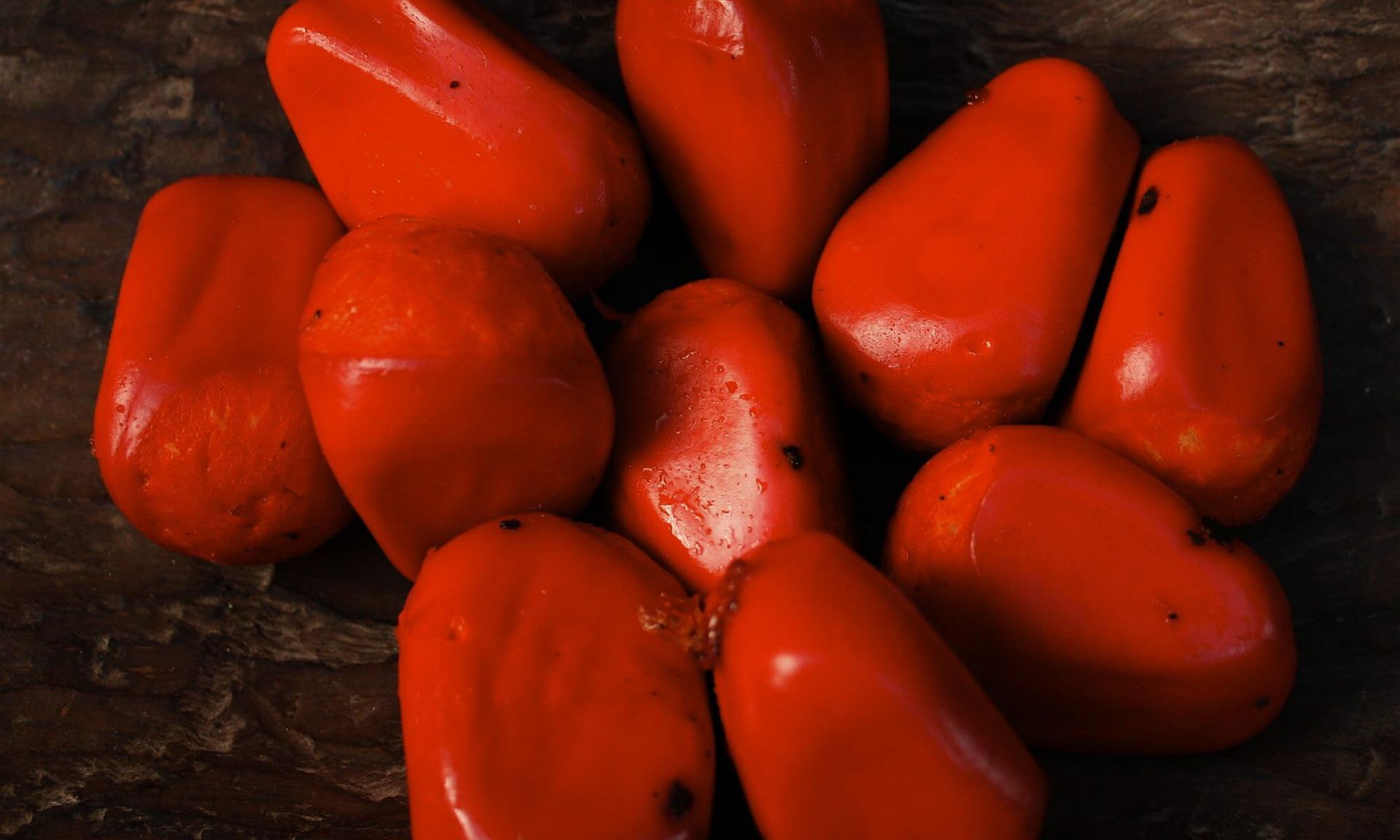Traditional significance of Nuytsia floribunda (“moojar” or “kaanya tree”)
Traditional Significance of Nuytsia Floribunda
‘When I die I shall go through the sea to Kurannup where all my moorurtung (relations) will be waiting on the shore for me, waiting with meat and drink for me…Kurannup is the home of my dead people and I must go to them, and my kaan-ya must be free to rest on the kaan-ya tree (Nuytsia floribunda) before it journeys through the sea. Since Nyitting (cold) times (long time ago) all Bibbulmun kaan-ya have rested on this tree on their way to Kurannup; and I have never broken a branch or flower, or sat under the shade of the tree because it is the kaan-ya tree only winnaitch (forbidden, sacred).’ (Noongar informant Joobaitch, see Bates in Bridge 1992: 14).1
When Noongar spokespersons were interviewed by us during an urban bushland heritage survey in the northern metropolitan area, after we had observed and recorded a grove of about fifteen Nuytsia floribunda trees growing on the leeward side of a coastal dune, the Elders reported that few people today understand the significance of the moojar tree (Nuytsia floribunda) commonly known as the Western Australian Christmas tree. They said that the moojar was regarded as “highly spiritual” because it was associated with the spirits of the dead who according to the ‘old people’ “camped” on the branches and flowers of the tree on their way to Kurannup – the land of the ancestors across the Western ocean. They said to us: ‘We don’t like to go near this tree.’
The cultural significance of Nuytsia floribunda is well established in the early ethnohistorical records. Daisy Bates in an article in The Australasian (1926 in Bridge 1992: 150) refers to it as the “ghost tree” and in a later publication (1938) “the tree of souls.” Her Noongar informants call it the moojarr or “Kaanya Tree” (kaanya, meaning recently departed soul). Bates emphasises that this tree was sacred to all Bibbulmun people throughout southwestern Australia from Jurien Bay to the east of Esperance. She categorically states that:
‘No living Bibbulmun ever sheltered or rested beneath the shade of the tree of souls; no flower or bud or leaf of the tree was ever touched by child or adult; no game that took shelter beneath it was ever disturbed.’ (Bates 1938 in Bridge 1992: 153)
Like all Noongar terms there are variant spellings for the term moojar. These include mooja, moodja, moojarr, moodjar, mudjarr, mutyal, modjar, mutyal, mutdhoor and others depending on the recorder. Lyon (1833 in Green 1979: 171) records mutdhoor as “Nuytsia, floribunda – the cabbage tree.” It was colonially known as the cabbage tree by the early explorers and settlers. Moore (1841:58) records the name for the tree as mut-yal and the gum as modyar or mo-diar (1842:100, 55). Symmons (1841) records the name as mutyal and the gum mod-jar. The meaning of this descriptor term mooja or moojar is uncertain; however, we would suggest that it means the same as “mootcha” that is, prohibited or forbidden. The term “mootcha” (also spelt “mootchoo“) was used by Daisy Bates to describe marriages that took place between prohibited/forbidden kin ‘contrary to native law.’ Such wrongful marriages were traditionally punishable by death.
Conflicting views on the edibility of the gum of Nuytsia floribunda
There are conflicting views in the popular literature as to the edibility of the gum of the moojar or ‘kanyaa tree.’ Some anecdotal accounts, including those on social media refer to the edible sweet sticky gum of Nuytsia as tasting very sweet and “yum.” One government publication by the Conservation and Land Management (CALM) on Bush Tucker authored by Daw, Walley and Keighery in 1997 refers to Noongar people eating the raw sweet oozing gum of Nuytsia floribunda. It states:
‘After taking slabs of wood from the trees to make shields, families returned later to collect and eat the raw, sweet gum that oozed from the wounded trees. They would also soak the flowers in water to make a sweet drink. (Daw, Walley and Keighery 1997: 28).
This view of the gum being edible is now ubiquitous on the internet and social media sources but it is a view NOT supported by Bindon (1996:186) who states in his book Useful Bush Plants that the gum of Nuytsia floribunda was not eaten by Noongar people. He points out that:
‘The trunk exudes a sweet sticky gum, which does not seem to have been eaten by humans.’
We believe that Bindon’s (1996) view possibly derives from the earlier work of Phillip Chauncy, the Government assistant surveyor in Perth, who in the 1840’s observed that Noongar people never touched the gum of the Nuytsia tree. Chauncy describes a demon known as Nyowalong that was culturally associated with Nuytsia floribunda as a deterrent to those tempted to eat the inedible gum. He states:
The Swan River Aborigines say that an evil being, called Nyowalong, wanders about in the night-time, in the Banksia forests, collecting the gum of the Nuytsia floribunda, which he puts into bags hanging all round his body. They assert that he is like an old man walking about in half-sitting attitude, and carrying a wanna, or yam-stick, and that he utters a short, sharp screech at every step. I enquired why they never speared him; but they were indignant at the idea and replied – “One might as well try to spear a grass tree, he is so surrounded with gum bags”. Although they eat the gum which exudes from the acacias, hakeas, and other trees, they never touch the Nuytsia gum; for, were they to do so, they say Nyowalong would certainly do them some secret injury; but the fact is, it is not an edible gum – they make a virtue of necessity.” (Chauncy 1878: 267-268).
When we asked Elders during a bushland survey in the northern metropolitan area of Perth whether the gum was used as a food or material glue, they said they had never heard of the gum being used for any purpose. Most responded by saying that the gum was hard to find and no one they knew had tasted it. When we asked if they thought that the gum might be poisonous, they said they did not know. A number of years later one of us (Ken) tasted a sample of Nuytsia gum in the natural bushland at Beeliar (south of Perth). He sampled it with the utmost caution in case it contained potential toxins. Ken reported that it did not taste sweet but was somewhat acrid and unpleasant.
In 2014 Professor Stephen Hopper tasted the gum of Nuytsia floribunda growing at the Royal Botanic Gardens Cranbourne (Melbourne). The gum was described by one of his colleagues, Professor Tim Entwisle, who also tasted it as
‘transparent to amber coloured resin. With a texture, and as it turns out taste, like silicon sealant…. it wasn’t sweet. In fact it wasn’t anything. Just like I imagine silicon sealant would taste without the drying spirit added to it. We didn’t die or fall ill. We just didn’t want to eat any more.’ http://talkingplants.blogspot.com/2014/10/western-australian-christmas-tree-not.html
Conflicting views on the edibility of the roots of Nuytsia floribunda
When we asked Noongar Elders whether they had eaten or tasted the roots of the moojar, one said that his auntie who had read a book on Bush Tucker told him that Noongar people used to dig up the young roots of the moojar in spring time and that they tasted sweet and juicy. But he said that his ‘mob’ had never eaten the roots because he said:
‘We were always too scared to touch this tree… it’s winnaitj.’
There is much anecdotal information available on the internet and in some bush tucker articles and books which all refer to the edibility of the sweet roots of Nuytsia floribunda. However, no one we know including ourselves who have tasted the woody roots of the suckers of the Western Australia Christmas tree have found them to be sweet. We were curious to investigate where the idea came from that the roots of the Christmas tree were edible and tasted like “candy.” It would appear to derive from the work of Ethel Hassell whose observations at Jerramongup station where she was living with her family in the late 19th century include the following vague nostalgic account describing her mungah experience :
‘Just after Christmas, my husband took me to visit our nearest neighbours who lived nearly fifty miles away. …. On the way I saw in the distance on the plains a clump of most beautiful tall trees covered with deep orange-coloured blossoms. We could see them standing out about five miles away. As we drove past we saw six or seven natives busily digging up the suckers which grew very profusely around these trees. We stopped to speak to the natives and they gave me one of the roots to taste, telling me it was called *mungah. The outer skin was pale yellow but easily stripped off leaving a moist brittle centre tasting very like sugar-candy. Very few of these trees grew near us, and none within walking distance as far as I was concerned, but the women used to occasionally bring me pieces to chew. There were many other edible roots, but these were the principal ones that grew where I lived. They were all very sweet and more of less of a watery nature, never mind how dry the ground was in which they grew.’
We find Hassell’s (1975: 26) account of her mungah root-tasting experience a little confusing. We would suggest that mungah is probably a variant spelling of mungart, mangart, mungyt, mungyte meaning ‘sweet’ or “sweetness” (e.g. Banksia nectar), see our Banksia paper https://www.anthropologyfromtheshed.com/some-notes-on-banksia-usage-in-traditional-noongar-culture According to Hammond (1933: 82) the term mungyt refers to ‘sugar, honey or anything sweet.’ One of us (Ken) has tried tasting the roots of the young suckers of Nuytsia during the hot dry season but they were not sweet. He described them as an “unpalatable chew.” We are not convinced that Hassell’s sweet tasting roots are those of the Western Australian Christmas tree.
It is interesting that Hassell does not identify mungah to an identifiable tree species. Nor does Davidson, the American anthropologist who published parts of Hassell’s manuscript in 1935 and 1936 in which these “mungah” roots are referred to. Based on our research it was not until 1974 that Hassell’s “mungah” was attributed to Nuytsia floribunda by Sara Meagher (1974: 59) in her work ‘The food resources of the Aborigines of the south-west of Western Australia’ published by the Western Australian Museum for whom she worked at the time. A year later Meagher (1975: 26) edited Hassell’s book My Dusky Friends and inserted an editorial note beside the term mungah saying ‘thought to be Nuytsia floribunda.’ This attribution to species has never been scientifically tested or confirmed not even by the Western Australian Museum who published her work. It is very easy to make assumptions from vague historical descriptions, including those based on reminiscences written many years after the event, but jumping to conclusions and making assumptions and assigning a Linnaean species name to an unidentified Noongar food can be dangerous.
In our view contemporary researchers too blindly accept the writings of earlier recorders as if they were “ethnographic fact” without conducting any rigorous scientific or even academic analysis of the ethnohistorical sources, context and cultural accuracy. Early ethnohistorical observations were conducted in a context where difficulties with language on both sides often led to cultural misinterpretations and many of these observations have never been questioned or critiqued from a cultural accuracy point of view. Independent scientific investigations and tests are needed to ensure that foods such as the mungah roots being attributed to Nuytsia floribunda is ethnographically accurate, if only for public safety.
Collecting the flowers of Nuytsia and making it into a sweet beverage?
We asked the Elders whether they had used or heard about the flowers of the mooja tree being used for the purpose of collecting nectar. Some said they had heard stories that the flowers may have been used for nectar but they were unsure who had told them about this. We were aware of many anecdotal sources on the internet which referred to the flowers of Nuytsia being made into a sweet drink and even into a heady alcohol but as far as we could ascertain this information came from a Western Australian government publication by the Conservation and Lands Department (CALM) authored by Daw, Walley and Keighery (1997: 28) which describes how Noongar people used to ‘soak the flowers in water to make a sweet drink.’ But, apart from this reference, we could find no supporting evidence or reference to this practice in the ethnohistorical or ethnobotanical literature. Meagher (1974: 45) and Bindon (1996:186) do not make any mention of indigenous people soaking the nectareous flowers of Nuytsia and making it into a drink. There are many ethnohistorical references to the soaking of the nectareous flowers of the Banksia and the flowers of the marri, jarrah and Grevillea but not the Nuytsia.
When we asked these same Elders if they had heard about the wood of the moojar tree being used in the production of artefacts, one spokesman said he had heard about Noongar people making shields out of the wood but he doubted that this happened around Perth for they weren’t known for making shields. This is true. The people of Perth and the southwest were experts at “spear dodging” and they did not need shields to deflect enemy spears. Moore (1842) also states that shields (wunda) were not traditionally used or made in the Perth area but were traded from the north, when needed. He says:
‘The use of them [shields] is not at all common among the natives in the located parts of Western Australia, who bring them as great curiosities from the north to the settlers.’
Chauncey in Brough-Smyth (1878) refers to shields being made from Nuytsia floribunda by the tribes living to the north of Perth.
‘Some of the ancients took much delight in ornamenting their shields with all sorts of figures – birds, beasts, and the inanimate works of Nature. In like manner, the natives of Western Australia – at least some tribes north from Perth – adorn their narrow shields which are made of the soft wood of the Nuytsia florabunda [sic]. They are only about two and a half feet long by four inches wide in the middle, and taper to a point at each end. They are convex, with a handle inside, cut out of the one piece of wood, and are almost as light as cork, and generally elaborately carved. Many of the tribes, however, use no shield at all.’
Summary
In this article we have tried to highlight the opposing views in the literature regarding the edibility of the gum of Nuytsia floribunda. The Assistant surveyor for the Perth region, Mr Philip Chauncy (1886) noted in the 1840’s that the Swan River Aborigines never ate the Nuytsia gum. Bindon (1996:186) in his book Useful Bush Plants published by the Western Australian Museum also suggests that the gum of Nuytsia floribunda was not eaten by people.
And yet anecdotal internet sources and government documents and brochures ubiquitously refer to this gum and tree roots as being edible and sweet tasting and reference the flowers being made into a sweet drink. An audio recording on the internet by the Australian Broadcasting Commission describes how the flowers were soaked and made into a mild alcoholic beverage. We think this is irresponsible of the ABC to put such information out into the public realm without any scientific research. It is well known that Noongar people soaked the flowers of Banksia and some Eucalpytus and Grevillea to extract the sweet nectar but did they use the flowers of the “tree containing souls?”
We still are not convinced that the roots which Hassell (1975:26) describes as tasting like ‘sugar candy” are those of the Western Australian Christmas tree, as Meagher (1974, 1975) and others would have us believe. We think that Hassell may have been referring to the consumption of a sweet-tasing root bark which was a traditional food consumed or chewed in the hot dry season providing a source of moisture and sweetness, although Hassell’s description does not fit the way in which Euclapyptus or mallee root bark was consumed. See our paper on root
bark https://anthropologyfromtheshed.com/project/root-bark-eating-in-southwestern-australia/
Until scientific testing is carried out to determine the edibility of the raw gum, roots and flowers of Nuytsia floribunda, they will continue to be surrounded by uncertainty and untested anecdotal information. This is potentially very dangerous. See our blog https://anthropologyfromtheshed.com/beware-bush-food-can-be-dangerous/
Correct information before attempting to consume any bush foods is essential. Reliable and scientific information needs to be made available to the public to avert potentially dangerous situations from arising. This research should be conducted in partnership and collaboration with indigenous people in a way that provides recognition of their traditional scientific knowledge (TSK) which has largely been unrecognised in the anthropological, archaeological and scientific literature to this day, despite it having been fundamental to their survival for over 60,000 years. See our blog on indigenous
science https://anthropologyfromtheshed.com/indigenous-science/
This paper is based on archival research and field interviews between 1992 and 2005 with Noongar spokespersons from the Perth, Pinjarra and Moora areas. We would like to thank all Noongar people who have over the years participated in heritage surveys and shared their knowledge of indigenous bush foods and their preparation.
Annotations
- Joobaitch was one of Daisy Bates’ informants from the Guildford area who died in 1907. He was ‘a storehouse of the laws, traditions and folklore of his people’ and he never picked the flowers or branches or sat beneath the shade of the “spirit tree” (Nuytsia floribunda). (Bates in Bridge 1992).
BIBILOGRAPHY
ABC Great Southern WA 2013 ‘Celebrating Noongar Christmas Tradition’ http://www.abc.net.au/local/audio/2013/12/10/3908763.htm
Bates, D. 1985. The Native Tribes of Western Australia. Isobel White (Ed.) Canberra: National Library of Australia.
Bates, Daisy 1992 Aboriginal Perth: Bibbulmun Biographies and Legends. Peter J. Bridge (ed.) Carlisle, Perth: Hesperian Press.
Bindon, P. 1996 Useful Bush Plants. Perth: Western Australian Museum
Bindon, P. and Chadwick, R. (eds.) 1992 A Nyoongar Wordlist from the South-West of Western Australia. WA Museum, Anthropology Department.
Brough Smyth, R. B. 1878 The Aborigines of Victoria. 2 vols. Melbourne and London.
Cameron, J.M.R. and P. Barnes (eds.) 2014 Lieutenant Bunbury’s Australian Sojourn: the letters and journals of Lieutenant H.W. Bunbury, 21st Royal North British Fusiliers, 1834-1837. Victoria Park, WA: Hesperian Press.
Chauncy, Phillip 1878 ‘Notes and Anecdotes’ in R. Brough Smyth 1878 The Aborigines of Victoria. Vol 1. Melbourne and London.
Daw, B., Walley, T. and Keighery, G. (1997). Bush Tucker Plants of the South West. Department of Conservation and Land Management, Western Australia.
Dench, A. 1994 ‘Nyungar’ in Thieberger, N. and W. McGregor Macquarie Aboriginal Words. Macquarie University, N.S.W.
Drummond, J. 1840 ‘Report on the botanical productions of the country from York district to King George’s Sound.’ The Perth Gazette and Western Australian Journal. September 24.
Entwisle, Tim 2014 ‘Western Australian Christmas tree not so sweet in the East.’ October 28. http://talkingplants.blogspot.com/2014/10/western-australian-christmas-tree-not.html
Green, N. 1979 Nyungar – The People: Aboriginal customs in the southwest of Australia. Mt Lawley, North Perth: Creative Research Publishers.
Grey, G., 1840 A Vocabulary of the Dialects of South Western Australia. London: T. and W. Boone.
Hallam. S. J. 1975 Fire and Hearth: a study of Aboriginal usage and European usurpation in south-western Australia. Canberra: Australian Institute of Aboriginal Studies.
Hammond, J.E., 1933 Winjan’s People. Perth: Imperial Printing Co.
Hassell, Ethel 1975 My Dusky Friends: Aboriginal life, customs and legends and glimpses of station life at Jarramungup in the 1880’s. East Fremantle: C.W. Hassell.
Lyon, R.M. 1833 ‘A Glance at the Manners, and Language of the Aboriginal Inhabitants of Western Australia; with a short vocabulary’. In N. Green (Ed.) Nyungar – The People: Aboriginal customs in the southwest of Australia. Perth: Creative Research Publishers.
Marchant, N.G.; Wheeler, J.R.; Rye, B.L. Bennett, E.M.; Lander N.S. and T.D. Macfarlane 1987 Flora of the Perth Region. Part One.
Meagher, S.J., 1974 The food resources of the Aborigines of the south-west of Western Australia. Records of the West Australian Museum 3(1): 14–65.
Moore, G.F. 1841 ‘Aborigines of Australia – Swan River: Domestic Manners.’ The Colonial Magazine and Commercial Maritime Journal. May to August 1841. Vol. V. London: Fisher Son & Co. Edited by Robert Montgomery Martin Esq. pp. 309-315.
Moore, G.F. 1842 A Descriptive Vocabulary of the Language in Common Use Amongst the Aborigines of Western Australia. London: Orr.
Nind, Scott 1831 Description of the Natives of King George’s Sound (Swan River Colony) and adjoining country. The Journal of the Royal Geographical Society of London, Vol 1, pp. 21-51. Written by Mr Scott Nind, and communicated by R.Brown Esq. Read 14th February.
Salvado, R. 1851 in E.J. Storman 1977 The Salvado Memoirs. Nedlands: University of Western Australia Press.
Shoobert (ed.) 2005 Western Australian Exploration 1826-1835, The Letters, Reports & Journals of Exploration and Discovery in Western Australia. Vol 1. Victoria Park: Hesperian Press.
Stormon, E.J. 1977 The Salvado Memoirs. By Dom Rosendo Salvado, O.S.B. Translated and edited by E.J. Stormon. Nedlands: University of Western Australia Press.
Symmons, Charles 1841 Grammatical Introduction to the study of the Aboriginal languages of Western Australia. Perth: Western Australian Almanack.
White, I. (Ed.) 1985 The Native Tribes of Western Australia. Canberra: National Library of Australia.
Whitehurst, Rosemary 1992 Noongar Dictionary: Noongar to English and English to Noongar. Compiled by Rosemary Whitehurst. First Edition. Bunbury: Noongar Language and Culture Centre. (Whitehurst records moodjar as Christmas tree, see page 18, online dictionary, Second edition 1997 available at https://d1y4ma8ribhabl.cloudfront.net/wp-content/uploads/2013/07/Noongar-Dictionary-Second-Edition.pdf
